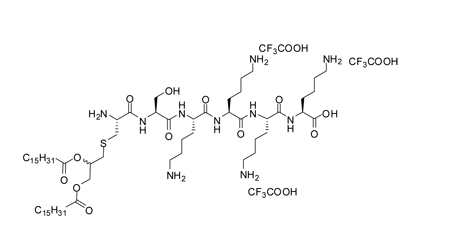TLR2(6) agonist TLR2(6) 拮抗剂,与TLR2(6)蛋白竞争性结合,阻止其他蛋白与他结合。Pam2CSK4 Synthetic diacylated lipoprotein Pam2CSK4 is a synthetic diacylated lipopeptide (LP).
TLR2(6) agonist TLR2(6) 拮抗剂,与TLR2(6)蛋白竞争性结合,阻止其他蛋白与他结合。Pam2CSK4 Synthetic diacylated lipoprotein Pam2CSK4 is a synthetic diacylated lipopeptide (LP).
Pam2CSK4
美国InvivoGen Invivogen主要提供抗生素,转染试剂,细胞因子,细胞系,质粒等产品。抗生素涵盖了细胞培养、筛选全系列,如Blasticidin S,Hygromycin B, Phleomycin, Primocin, Zeocin等细胞分选常用抗生素。尤其以抗细胞支原体污染的抗生素Plasmocin™zui为出名,该抗生素因其卓越性能受到客户一致好评。
Synthetic diacylated lipoprotein
Pam2CSK4 is a synthetic diacylated lipopeptide (LP). According to the current model, diacylated LPs induce signaling through TLR2/6.
However, it was also reported that Pam2CSK4 induces signaling in a TLR6-independent manner. This finding suggests that both the lipid and peptide part of lipoproteins take part in the specificity of recognition by TLR2 heterodimers.
Catalog code change notification
The catalog code of Pam2CSK4 has been changed from “tlrl-pam2” to “tlrl-pm2s” to notify a modification in the production process. Pam2CSK4 “tlrl-pam2” was synthesized in a liquid form, Pam2CSK4 “tlrl-pm2s” is produced by solid-phase peptide synthesis.
Specifications
Specificity: TLR2(6) agonist
Working concentration: 1 – 100 ng/ml
Molecular formula: C65H126N10O12S, 2TFA
Molecular weight: 1271.85
Endotoxin level: <0.001 EU/μg
Solubility: 1 mg/ml in water
Details

Contents
• Pam2CSK4 is available in two quantities:
– 100 μg: tlrl-pam2
– 1 mg: tlrl-pam2-1
• 1.5 ml sterile endotoxin-free water
Pam2CSK4 is provided as a lyophilized powder and shipped at room temperature. Store at 4°C. Upon resuspension prepare aliquots of Pam2CSK4 and store at 4°C for short term storage or -20°C for long storage. Resuspended product is stable 1 month at 4°C and 6 months at -20°C when properly stored.
Description
Pam2CSK4 is a synthetic diacylated lipopeptide (LP). Bacterial lipoproteins are strong immune modulators that activate early innate host responses after infection. LP analogs of these lipoproteins signal either through TLR2/1 or TLR2/6 heterodimers. According to the current model, triacylated LP like Pam3CSK4, are recognized by TLR2/1, whereas diacylated LP, such as FSL1, induce signaling through TLR2/6. However, it was recently reported that diacylated LP, such as Pam2CSK4, induce signaling in a TLR6-independent manner [1]. This finding suggests that both the lipid and peptide part of lipoproteins take part in the specificity of recognition by TLR2 heterodimers.
1. Buwitt-Beckmann U. et al., 2005. Toll-like receptor 6-independent signaling by diacylated lipopeptides. Eur J Immunol. 35(1):282-9.
Citations
Recent articles using Pam2CSK4
•2011 – J Immunol., 186: 5916 – 5926
Synergistic interactions of TLR2/6 and TLR9 induce a high level of resistance to lung infection in mice.
Duggan JM, You D, Cleaver JO, Larson DT, Garza RJ, Guzman Pruneda FA, Tuvim MJ, Zhang J, Dickey BF, Evans SE.
Free article
•2012 – Immunity, 36(3):464-476
An NLRP7-containing inflammasome mediates recognition of microbial lipopeptides in human macrophages.
Khare S, Dorfleutner A, Bryan NB, Yun C, Radian AD, de Almeida L, Rojanasakul Y, Stehlik C
•2011 – Clin Vaccine Immunol., 18(11):1834-1844
Assessment of Lactobacillus gasseri as a candidate oral vaccine vector
Stoeker L, Nordone S, Gunderson S, Zhang L, Kajikawa A, LaVoy A, Miller M, Klaenhammer TR, Dean GA
Free article

